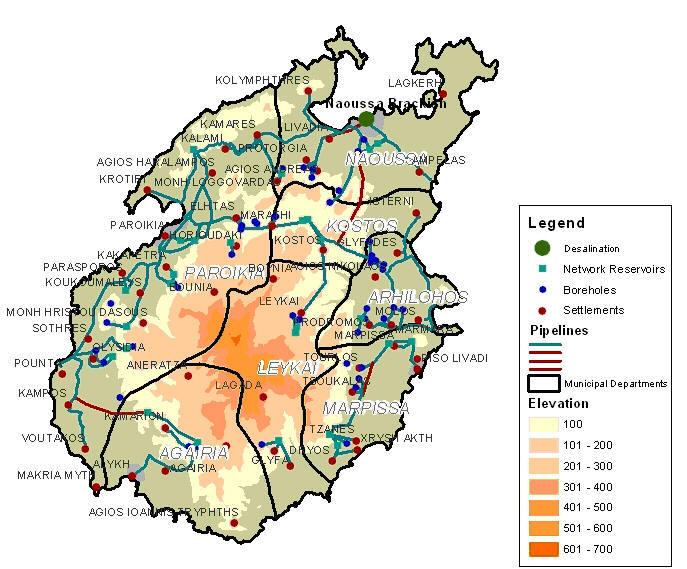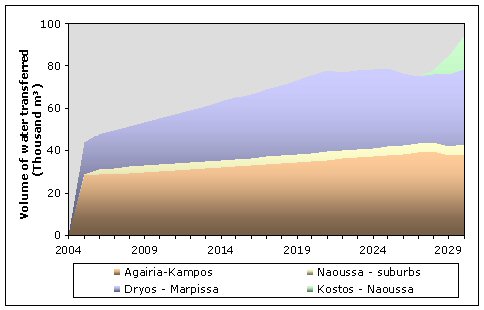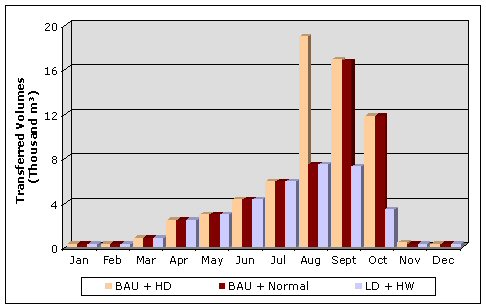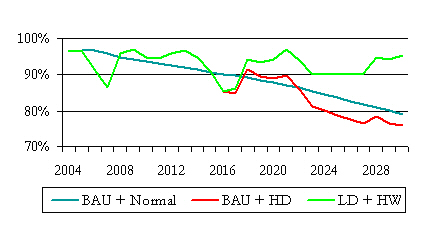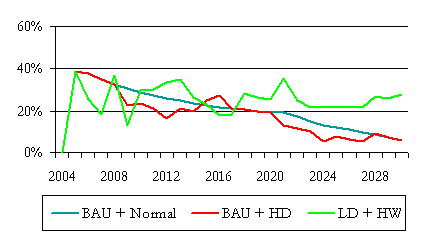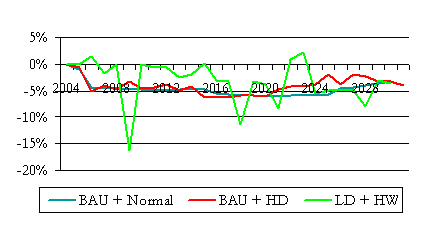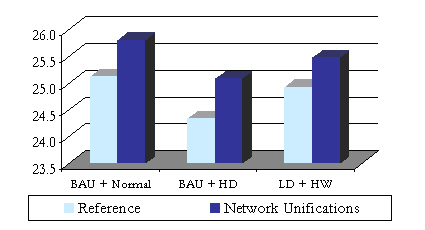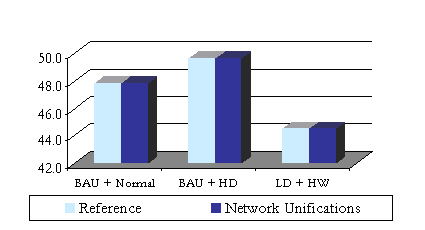
ISSUE 6 |
|||||||||||||||||||||||||||||||||||||||||||||||||||||
|
|
||||||||||||||||||||||||||||||||||||||||||||||||||||
|
|
|||||||||||||||||||||||||||||||||||||||||||||||||||||
Option details and results |
|||||||||||||||||||||||||||||||||||||||||||||||||||||
|
The first three of the proposed connections are considered necessary, since the areas to be supplied face permanent water shortage problems. Between scenarios it is the appropriate connection years that will vary and that will be assessed. The cost of the new connections, estimated according to their length and pipeline diameter, is presented in Table 1. |
|||||||||||||||||||||||||||||||||||||||||||||||||||||
|
Table 1. Network unification costs
Under normal (average) water availability conditions, the first three connections are implemented in 2005. Since the settlement of Naoussa does not face deficiency problems before the year 2021, the connection should be made much later, in 2028. Figure 1 presents the total volume of water transferred by each connection under the BAU + Normal scenario. Figure 1. Volume of water transferred from each connection (BAU + Normal scenario) In dry years transferred volumes normally increase during the summer months, with the provision that local water needs are always satisfied before any transfer is made. Monthly distribution differs for average or wet years. In some areas (e.g. Paroikia) already existing infrastructure is adequate to meet water needs up to the peak month of August. After that however, local resources are depleted, and additional water transfers are required for meeting the demand.
Figure 2. Monthly volumes of water transferred for the three scenarios (year 2009) |
|||||||||||||||||||||||||||||||||||||||||||||||||||||
Effectiveness |
|||||||||||||||||||||||||||||||||||||||||||||||||||||
|
Under average availability conditions, the unification of the island’s fragmented networks can lead to an increase in domestic demand coverage. Overall, when water availability is increased due to increased precipitation, there is a significant effect on the domestic demand coverage, due entirely to a better allocation of the available resources (Figures 3 and 4). The effect becomes smaller as demand increases, since larger water quantities are required for satisfying local needs before making water transfers through the new connections, and since no additional water supply sources have been introduced in the system. Figure 3. Percent demand coverage effectiveness of Network Unifications to Domestic use
Figure 4. Percent Improvement of deficit in Domestic use with respect to the reference scenarios Network unifications have a positive effect only in domestic demand coverage, which is higher under a high frequency of wet years (LD + HW scenario). Irrigation demand coverage (Figures 5 and 6) is overall decreased over time due to the increasing demand for domestic use. A similar pattern of effectiveness improvement as with the domestic use is observed where the overall water availability is significantly increased due to increased precipitation. Figure 5. Percent demand coverage effectiveness of Network Unifications to Irrigation use
|
|||||||||||||||||||||||||||||||||||||||||||||||||||||
Direct and Environmental Costs |
|||||||||||||||||||||||||||||||||||||||||||||||||||||
|
Overall the option is not very expensive, since the unifications proposed are between neighbouring municipal departments and construction costs are low (Table 1). Additional cost is incurred from the augmentation of water distributed through the network but in any scenario this increase does not exceed 5% of the respective reference scenario direct cost, expressed in present value terms (Figure 7). The present value increase of the option under the LD+HW scenario is much lower, since the most expensive connection between Kostos and Naoussa is not required. An additional remark is related to the most expensive connection between the municipal departments of Kostos and Naoussa. This connection is used only after 2028, when the installed desalination capacity cannot meet the demand, and is required only under normal or dry conditions. Additionally, the unification creates problems in the provision of water supply to the Paroikia municipal department. Therefore, the connection should - if realised - be combined with the construction of new boreholes or other supply enhancement measures in order to stabilise the supply delivered to the other regions from the boreholes of Kostos area. Figure 7. Total direct cost difference of the Network Unifications option under the three scenarios (Present Value – Million €) The total environmental costs for network unifications do not vary significantly between the intervention scenario and the reference conditions for each availability/demand scenario (Figure 8); this is due to the fact that the environmental cost is calculated at the level of the resource and on the basis of total abstraction levels. The option does not affect groundwater abstraction levels; all available water resources are considered exploited and the increase of domestic abstractions is followed by a decrease of irrigation abstractions. Therefore, the total volume of water abstracted from each aquifer remains at the same level as with the reference scenario, and total environmental costs are more or less constant. Figure 8. Total environmental cost difference of the Network Unifications option under the three scenarios (Present Value – Million €) |
|||||||||||||||||||||||||||||||||||||||||||||||||||||
